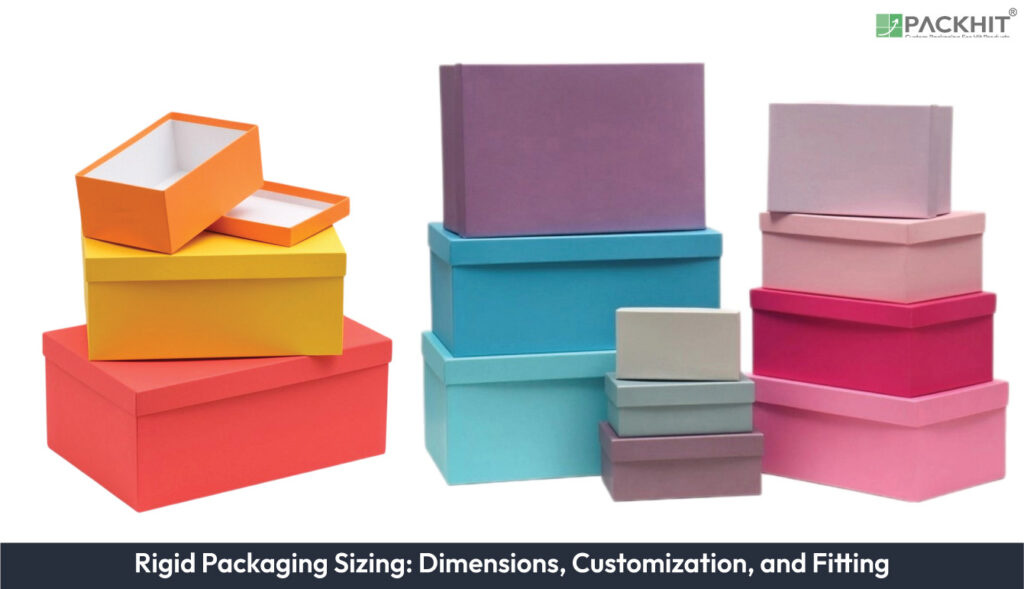Rigid packaging sizing encompasses the essential attributes of dimensions, customization, and fitting, which collectively ensure optimal product compatibility and enhance operational efficiency. Dimensions, including internal and external measurements along with material thickness, define the spatial characteristics and durability of the packaging. Customization adapts packaging design, materials, and finishes to suit specific product and brand requirements, while fitting ensures secure containment, preventing damage, and facilitating usability. These aspects of rigid packaging sizing influence manufacturing processes, logistical operations, and the overall sustainability of packaging solutions.
What are the Key Dimensions in Rigid Packaging Sizing?
The dimensions of rigid packaging are typically categorized into three primary measurements: internal dimensions, external dimensions, and material thickness. These parameters collectively define the spatial characteristics of the packaging and its compatibility with the enclosed product.
Internal Dimensions
Internal dimensions refer to the usable space within the packaging, measured as the length, width, and height of the interior cavity. These measurements are critical for ensuring a snug fit for the product, minimizing movement during transit, and preventing damage. For instance, a rigid box designed for electronics may have internal dimensions of 200 mm x 150 mm x 50 mm, tailored to the product’s exact specifications.
External Dimensions
External dimensions account for the overall size of the packaging, including the material thickness. These measurements are essential for logistical considerations such as palletization, storage, and transportation. For example, a rigid box with internal dimensions of 200 mm x 150 mm x 50 mm and a material thickness of 3 mm would have external dimensions of 206 mm x 156 mm x 56 mm.
Material Thickness
Material thickness, often measured in millimeters or points, influences both the internal and external dimensions of the packaging. It also affects the structural integrity and durability of the packaging. Common thicknesses for rigid packaging materials, such as paperboard, range from 1.5 mm to 3 mm, depending on the application and required strength.
How is Customization Achieved in Rigid Packaging?
Customization in rigid packaging involves tailoring the design, materials, and finishes to meet specific functional and aesthetic requirements. This process includes structural modifications, material selection, and the application of decorative elements.
Structural Customization
Structural customization focuses on altering the shape, size, and configuration of the packaging to suit the product’s unique characteristics. Examples include the addition of compartments for multi-component products, die-cut windows for product visibility, and collapsible designs for space-saving storage.
Material Selection
The choice of materials plays a pivotal role in customization. Manufacturers may opt for high-density paperboard for enhanced durability, eco-friendly materials for sustainability, or specialty coatings for moisture resistance. Each material choice impacts the packaging’s performance, cost, and environmental footprint.
Decorative Finishes
Decorative finishes enhance the visual appeal and branding potential of rigid packaging. Techniques such as embossing, foil stamping, and spot UV coating are commonly used to create premium aesthetics. For instance, a luxury watch box may feature gold foil stamping and a velvet-lined interior to convey exclusivity.
What Factors Influence Fitting in Rigid Packaging?
Fitting in rigid packaging refers to the alignment between the packaging and the product, ensuring secure containment and ease of use. Key factors influencing fitting include tolerances, closure mechanisms, and product-specific requirements.
Manufacturing Tolerances
Manufacturing tolerances define the permissible variations in dimensions during production. Tight tolerances are essential for achieving a precise fit, particularly for high-value or fragile products. For example, a tolerance of ±0.5 mm may be specified for rigid packaging used in the electronics industry.
Closure Mechanisms
Closure mechanisms, such as magnetic clasps, friction-fit lids, or adhesive seals, contribute to the functionality and security of the packaging. The choice of mechanism depends on the product’s weight, usage frequency, and tamper-resistance requirements.
Product-Specific Requirements
Product-specific requirements, such as shape, fragility, and storage conditions, dictate the fitting parameters. For instance, packaging for a glass perfume bottle may include custom-molded inserts to prevent movement and breakage during transit.
How Does Rigid Packaging Sizing Impact Manufacturing and Logistics?
Rigid packaging sizing has significant implications for manufacturing efficiency and logistical operations. Proper sizing reduces material waste, optimizes production workflows, and enhances supply chain performance.
Material Utilization
Accurate sizing minimizes material waste by ensuring that the packaging dimensions align closely with the product’s requirements. This not only reduces costs but also supports sustainability initiatives by lowering resource consumption.
Production Efficiency
Standardized dimensions streamline production processes by enabling the use of automated machinery and reducing setup times. Consistency in sizing also facilitates quality control and minimizes defects.
Logistical Optimization
Optimized packaging dimensions improve storage density, reduce shipping costs, and enhance pallet utilization. For example, packaging designed to fit within standard pallet dimensions (1,200 mm x 1,000 mm) maximizes the number of units per shipment.

